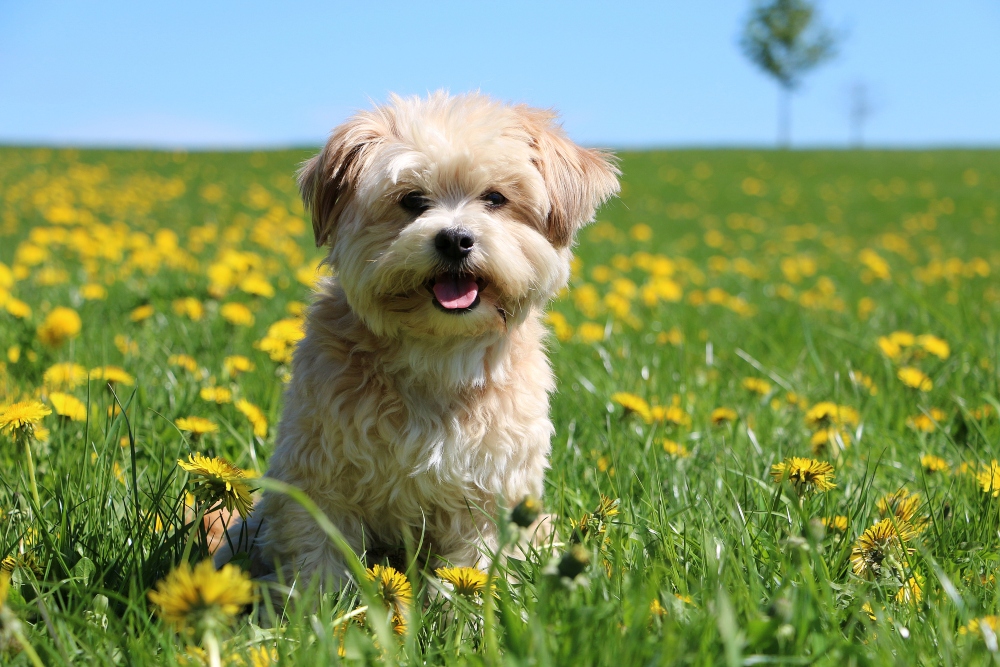Table of Contents
Introduction to Havanese Dogs
With their beautiful coat and playful personalities, Havanese dogs make wonderful additions to a family. These are intelligent and outgoing dogs that originate from Cuba and work well in city environments. Havanese dogs love doing tricks to please people and are favored for their trainability and affectionate nature. As part of the “toy” group of dog breeds, Havanese dogs are small in size and highly adaptable to nearly any type of environment.
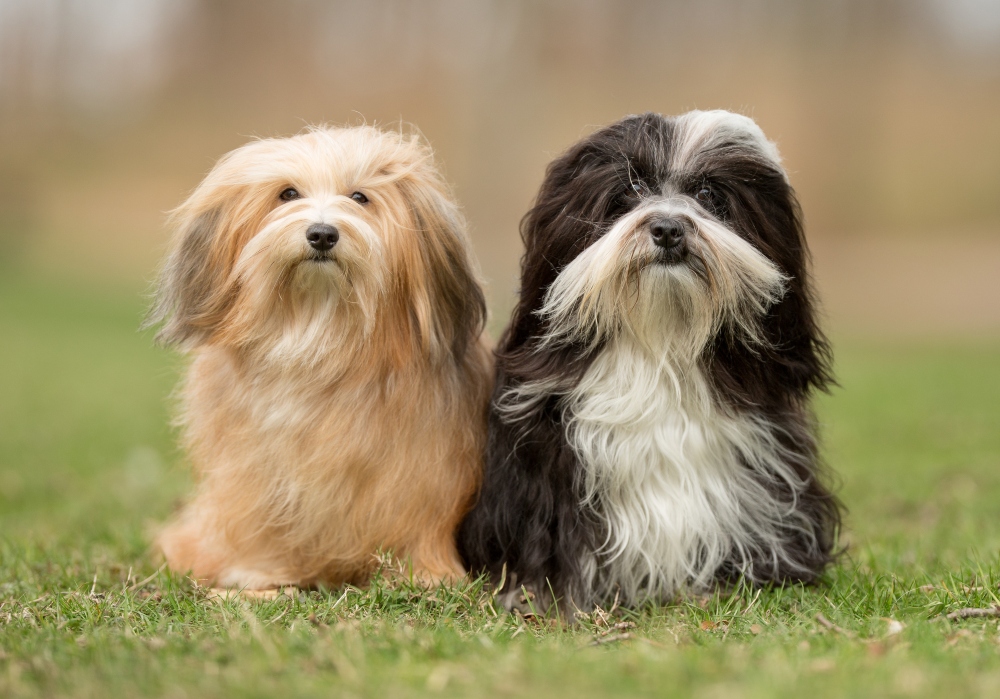
Size of Havanese Dogs
A purebred, adult Havanese will weigh between 7 and 13 pounds, which makes it a “toy” size dog. There is not a big difference in weight between male and female Havanese dogs. Both genders grow quickly between months 4 and 7, and then their weight gain slows down by about month eight. Most of these dogs will stop growing entirely by about 10 months of age.
Here’s how big you can expect your Havanese to get according to age.
| 2 months | 4 months | 6 months | 8 months |
|---|---|---|---|
| 3 pounds | 4 – 5.5 pounds | 6.5 – 7 pounds | 7-13 pounds |
With regard to height, a fully-grown Havanese will be about 8.5 to 11.5 inches tall.
Characteristics of Havanese Dogs
A Havanese is full of playful energy and great at learning tricks. These dogs are sometimes used as therapy dogs and have outgoing personalities that make them friendly with strangers when socialized early on. They are adaptable dogs that love attention, are fairly low-maintenance, and are quite trainable.
As you get to know a Havanese’s personality, here’s what you can expect according to their breed characteristics.
| Breed Characteristic | Level (High, Medium, Low) |
|---|---|
| Affectionate with People | High |
| Good with Kids | High |
| Good with Pets | High |
| Need for Exercise | Medium |
| Energy Level | Medium |
| Intelligence Level | High |
| Able to Be Trained | High |
| Amount of Barking | Medium |
| Amount of Shedding | Medium |
You might be surprised how much energy your Havanese has and how agile these dogs can be when playing. However, Havanese dogs do best when they are in close proximity to their family members and not left alone for long periods of time. In fact, they can become anxious by themselves and have a reduced quality of life if someone isn’t home at all during the day for company.
History of Havanese Dogs
The Havanese is the only dog breed that is native to Cuba and named after Cuba’s capital city of Havana. They originate from the Bichon family of small white dogs and are related to the Maltese and Bichon Frise. They have been known throughout history as the dogs of royalty and aristocrats because they have always been lapdogs rather than working dogs.
According to historians, Havanese dogs were brought to Cuba by Italian sea captains or Spanish colonizers who were seeking new lands in the 1600s. Other historical accounts link the Havanese to dogs in Malta and cite references to this type of dog in the writings of Aristotle. It is possible that the breed was crossed with Poodle dogs during its early days in Cuba. In fact, the dog has been called the Havana Silk Dog and the Spanish Silk Poodle in the past.
In 1959, Communism took over in Cuba, causing some residents to relocate to America with their tiny Havanese dogs. Today, Havanese dogs are now popular in the U.S. too and have gained attention all around the world. Famous Havanese dog owners include Charles Dickens and Ernest Hemingway. The American Kennel Club began recognizing the Havanese breed in 1996, making it the AKC’s 142nd breed.
Havanese Standard Information
As an AKC breed, there are certain standards that a Havanese must exhibit to be considered a purebred Havanese. In general, these dogs are longer than they are tall, have a double coat, and an untrimmed coat. This makes the Havanese a wonderful dog to pet and cuddle within a family environment.
Here is an overview of the breed standard information for Havanese dogs.
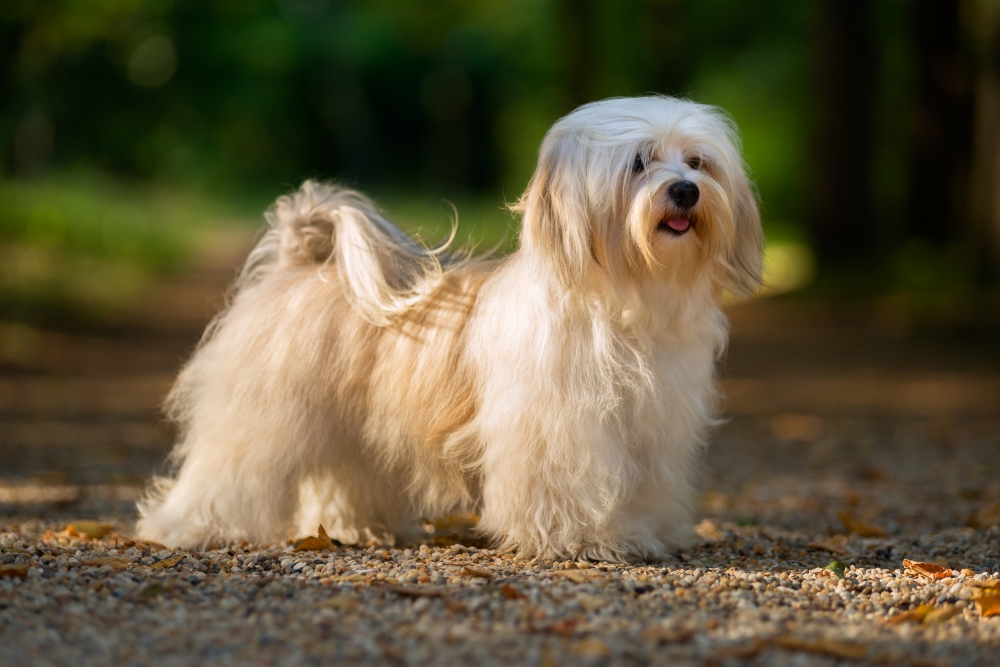
Head:
- Soft and intelligent expression
- Large, dark brown eyes
- Broad-base ears that have a distinct fold
- Broad and slightly rounded skull
- Muzzle full and rectangular with broad nose
- Scissors-type bite
Neck, Topline, Body:
- Neck slightly arched and moderate length
- Topline rises from withers to croup
- Body longer than height at withers
- Tail high-set and arches up over back
Forequarters:
- Neck blends smoothly into back
- Elbows tight to body
- Declaws may be removed
- Pads and toes any color
Hindquarters:
- Muscular hind legs
- Arched toes pointing straight ahead
- Hocks well let down
Coat:
- Silky coat that is soft and light in texture
- Long and wavy coat
- Coat may be corded
Color:
- All colors and markings are of equal merit
Gait:
- Springy gait due to short upper arm and rear drive
- Head carried high
- Pads visible during movement
Caring for Havanese Dogs
Grooming is very important for Havanese dogs because of their characteristically long and silky coat. This coat is great for protecting dogs from sunny and cold weather, but it does take some extra care.
Otherwise, these are moderately active dogs that benefit from daily exercise. They do well with children and other pets, and they love a steady dose of attention each day.
Here are some general tips for taking the best care of a Havanese
Best Living Environments:
- Apartments and other small living spaces are fine
- Does well with city life
- Don’t leave a Havanese alone for too long
- Loves children and other dogs
- Can live well in RVs and on camping trips
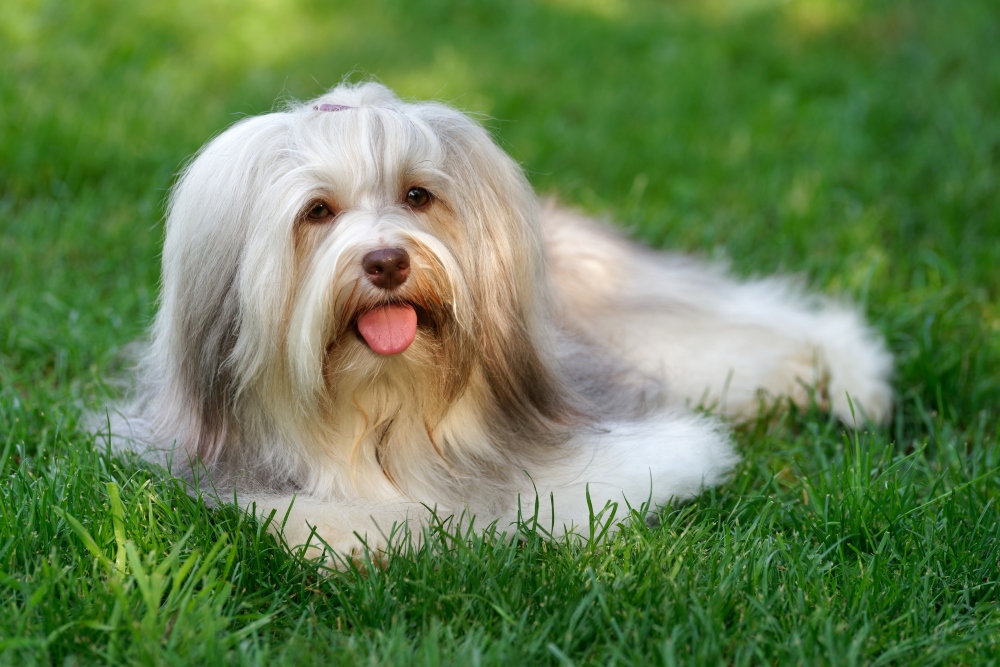
Type of Exercise:
- Running around in a yard
- Playing with toys in an indoor space
- Going on walks in the neighborhood
Mental Enrichment:
- Loves to watch activities going on outside from a comfy sofa
- Toys and treats for rewards
Training Strategies:
- Can be a challenge to housebreak
- May eat their own stools as puppies
- Can be trained to bark at an intruder but not bark unnecessarily
Grooming Tips:
- Doesn’t shed very much
- Regularly brush the coat
- Keep the coat long if you plan to show your dog professionally
- Brush the teeth (daily is ideal, but several days a week is also fine)
- Keep the nails trimmed
Common Health Problems of Havanese Dogs
Overall, Havanese are healthy dogs, but they don’t come without their fair share of health concerns as well. You can reduce the likelihood of your dog having health problems if you buy your dog from a reputable breeder and see health clearances from the puppy’s parents. A Havanese’s medical history is more of a mystery with an adopted dog, but with regular checkups, your pup can live a long, happy, and healthy life.
These are some of the most common health issues that arise with Havanese dogs.
- Hip and elbow dysplasia that may cause pain and require surgery
- Deafness caused by a genetic condition
- Patellar luxation, which is a loose kneecap
- Hypothyroidism caused by underactive thyroid glands
- Environmental allergies
- Cataracts, especially during older age
Havanese dogs have a life expectancy of about 14 to 16 years. When you visit your veterinarian for annual checkups, make sure to have your Havanese tested for any hearing, vision, hip, and knee problems. Annual checkups should also include routine laboratory tests (bloodwork, fecal exam, urinalysis) and vaccinations (if any are not up to date). During the checkup, make sure to purchase heartworm and flea and tick preventatives if you’re running low on either of these.
Diet and Nutrition for Havanese Dogs
It is generally best to feed a Havanese two meals per day and a total of ½ cup to 1 cup of dry dog food. A dog’s portions can be adjusted based on weight, age, metabolism, and level of daily activity. Havanese pet parents should know that these dogs are prone to becoming overweight. This is why you should measure food out for each meal rather than leaving food out for the dog to graze on throughout the day.
You should be able to see a Havanese’s waist and see (but not feel) their ribs without needing to press very hard. Diet and exercise levels should be adjusted accordingly to ensure the longevity of your pet. Recommended dog foods for Havanese dogs include Iams ProActive Health Adult Small Breed, Blue Buffalo Life Protection Formula Small Breed, and Cesar Puppy Classic Loaf in Sauce Chicken & Beef Recipe.
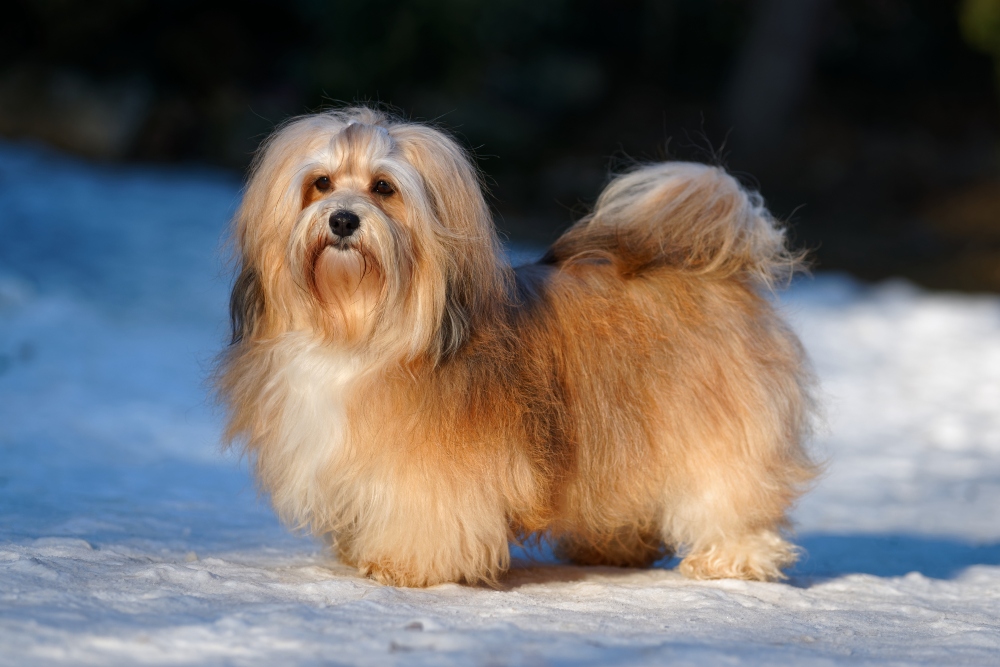
Where to Adopt or Purchase Havanese Dogs
If you are interested in purchasing a purebred Havanese puppy, you can browse the American Kennel Club marketplace to find Havanese from reputable breeders in your area. The Havanese Club of America is a national AKC Parent Club for this breed and offers education for puppy buyers, health information, and Havanese rescue resources.
Havanese Rescue, Inc. is a nonprofit organization that has been rescuing this breed and mixed-breed Havanese dogs since 2004. Other resources for people interested in adopting Havanese dogs include PetFinder, AdoptAPet.com, and Havanese Angel League Organization for Rescue.
Related Breeds
If a small, fluffy, and adorable pup is right up your alley, then you should know that there are quite a few “toy dog” options to choose from. In addition to the Havanese, you might also consider getting to know the following related dog breeds.
- Lhasa Apso
- Silky Terrier
- Bolognese
- Coton du Tulear
- Russian Tsvetnaya Bolonka
Pet Insurance for Havanese Dogs
To address the common genetic issues that affect Havanese dogs and also the conditions that simply develop with old age, Healthy Paws is the pet insurance company of choice for Havanese pet parents. We love dogs and are driven by our commitment to pet health in everything we do and every insurance plan we offer.
The Healthy Paws dog and puppy insurance plan offers coverage for Havanese dogs to protect your pup from injuries, illnesses, genetic conditions, and emergencies. This pet health insurance will help you take the very best care of your Havanese because it can help pay for x-rays, blood tests, surgery, hospitalizations, prescriptions, emergency care, alternative treatments, and more.
Just tell us a few details about your Havanese, and we’ll be happy to provide you with a pet health insurance quote today.

